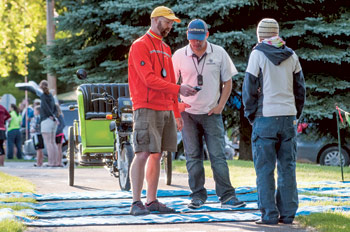Timing is everything.
Whether it’s a neighborhood 5K with a few dozen runners or a nationally renowned marathon with more than 5,000, the ability to accurately clock a racing event is both intricate and vital.
That’s where Whitefish resident Matthew Smeltzer comes in handy.
Racers across the state are likely familiar with Smeltzer’s business, Competitive Timing, which seems to be clocking racers at every finish line these days.
What began as a hobby three years ago now has Smeltzer racing around the state to professionally time events like the Glacier Challenge, Missoula Marathon and Governor’s Cup.
At the age of 35, Smeltzer quit his job of 17 years managing car rentals and turned Competitive Timing into a full-time operation.
The business has grown from coordinating results for a dozen local races to more than 60 across Montana this year.
“By no stretch of the imagination was it a business idea,” he said of his initial undertaking. “It was just something fun to do.”
Smeltzer now has one other full-time employee and a part-timer who helps during high-demand stretches in the summer.
His abilities as a professional timekeeper have branched out beyond traditional road races and can now cover the wide array of sporting activities, including Nordic ski and bike races, triathlons and multifarious contests like the Glacier Challenge, which covered land and water.
Last weekend Smeltzer tackled his largest task yet. Competitive Timing was in charge of tracking more than 5,000 runners winding through Missoula in the sold-out marathon, half marathon and 5K.
The high-profile event has grown substantially in seven years and was named the best marathon in the nation in 2009 by Runner’s World magazine.
The past two years, race organizers there have handed over the timing duties to Smeltzer instead of tabbing more established national companies.
And Smeltzer hasn’t disappointed.
“Having an organized, professional timer who pays attention to the details for these events is key. Nobody has done the job better or had the passion that Matthew has shown,” said Anders Brooker, race director of the Missoula Marathon.
What makes Smeltzer stand out is both his attention to detail and his eagerness to expand his services with the latest technology.
Racers who clip one of Smeltzer’s small timing chips to their shoelaces can find their pace, total time and rank by age, gender or overall finish. The results are available online or on location, where Competitive Timing computers display the results as they come in and a printer provides a free sticker with all the information for individuals.
As another innovative service, Smeltzer has set up cameras at the finish line of most races. The cameras provide backup in the rare event the chips malfunction, but primarily are used to catch footage of finishers. Then after the race, participants can click on their name and see a short YouTube clip of their accomplishment.
Smeltzer has also developed a new smartphone application and mobile website providing the same information in real time.
“He has gone above and beyond. He provides anything any big timer across the country would provide,” Brooker said. “We couldn’t be happier at this point.”
The tech savvy of Competitive Timing has set the new benchmark for organized competitions in Montana. Using Smeltzer’s timing system, the Carroll College Invitational cross country meet in Helena and the Frontier Conference Championships in Great Falls in 2010 became the first chip-timed collegiate events in the state. The following year, three prep races, including the state cross country meet in Helena and the massive Mountain West cross country meet in Missoula, became the first high school events to use chips.
All courtesy of Competitive Timing.
 |
|
Matthew Smeltzer, left, at the recent Glacier Challenge. – Lido Vizzutti | Flathead Beacon |
By 2011, the business was still a one-man hobby on the side even though the number of events grew to 20. It began to consume more time and effort than he could handle alongside his full-time job and family.
By 2012, it was obvious. Smeltzer had tapped into an industry with high demand. Races were seemingly held every weekend, and more kept popping up across the state. More race directors were demanding professional, accurate timers.
In April of that year, he made the leap, quit his job and focused fully on making Competitive Timing a viable second career.
“I felt pretty solid about things and Glacier Bank had enough faith in me to loan me some money,” he said.
Smeltzer also gained the faith of race directors who needed proof of Competitive Timing’s abilities.
“We had watched Matthew’s attention to detail with other races, and saw that he’s a professional timer,” Brooker said.
Last year’s Missoula Marathon helped vault Smeltzer’s career to the next level.
He continues to evolve his timing system and strive for more. At the recent Glacier Challenge, Smeltzer used soft ankle bracelets that competitors wore throughout the six legs of running, biking and paddling around Whitefish. Instead of forcing team members to hand off a baton-like device at each transition like last year, the bracelets tracked individuals once they crossed one of Smeltzer’s blue placer mats, automatically logging the time and triggering a new start.
“From that standpoint, he has been a huge asset to the race. It brings the Glacier Challenge up to a level that we could never get to without his services,” said Hannah Plumb, the race director of the Glacier Challenge.
“It’s really fun when racers from out of the area are amazed that we have those services, and all that credit really goes to Matthew.”
For more information about Competitive Timing, visit www.competitivetiming.com.